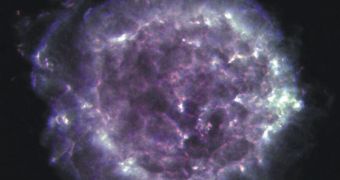Supernova events are some of the most energetic and powerful things that can go on in the Universe. When massive stars that reach the end of their burning cycle explode, they produce such fierce radiation emission and effects, that they briefly outshine entire galaxies. The death of such stars is called a supernova, and astrophysicists and astronomers have been working on methods of figuring out exactly what goes on in those instants for a very long time. Now, with the aid of new and advanced computer model, this could become fairly easy to accomplish, and in 3D, Nature News reports.
One of the key puzzles about supernova was how the heavier chemical elements at their cores (such as nickel), escaped the interior of the star before the lighter elements did. A paper published in the May 10 issue of the esteemed Astrophysical Journal holds the answer. German scientists from the Max Planck Institute for Astrophysics in Garching used their advanced supernova computer simulation software to model the events taking place inside the massive stars in three dimensions. They learned that heavy chemicals such as nickel tended to rush out of the blistering cores of dying stars in giant, mushroom-shaped blobs. These structures travel as fast as 4,000 kilometers per second, wrecking havoc in the surrounding layers of hydrogen gas.
MPI astrophysicist Hans-Thomas Janka plastically likens this event to a hernia. In all frankness, this is precisely what it looks like in his and his team's 3D computer model. The scientist says that reaching this capability was not easy. Due to the three-dimensional nature of the simulation, the computer hosting the model needs to account for variations in stellar densities, temperatures and velocities, all of which change by massive margins in very short time spans. And it's precisely these interactions that underlie the basic principles of how supernovae work. In other words, these variations are the very targets of study for astrophysicists. Understanding the processes going on in the first milliseconds of a supernova explosion, right at the innermost core of a ding star, is the ultimate goal for scientists.
Supernovae can appear through other mechanisms as well. For example, in a binary star system consisting of two white dwarfs, one may be consuming, or accreting, matter from the other. Over time, it gobbles up so much matter that it becomes unstable. When this happens, the “stealing” white dwarf will detonate, casting away all of its excess matter, and reverting to a state of equilibrium. The process can repeat itself several times over, astronomers say, until either of the two stars is destroyed.

 14 DAY TRIAL //
14 DAY TRIAL //